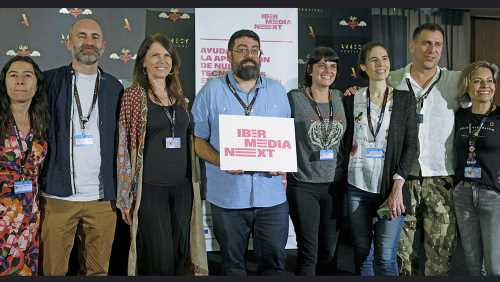Seeking to recharge the animation sector in Latin America, Spain and Portugal, regional fund Ibermedia touted its latest initiative at Annecy, following its May reveal at the Quirino Awards.
Ibermedia Next, a funding scheme seeking to back innovation and ingenuity into upcoming productions, enjoyed a strong boost at MIFA, with Quirino Awards executive producer José Luis Farias hosting a conference Thursday detailing its merits and outlining the application process, alongside several networking opportunities.
Assessment Committee and Consultancy members, who’ll select grant-receiving projects and guide their development, were also revealed.
Grants of up to €150,000 ($163,500) are on offer, in tandem with a support program valued at up to €95,000 ($103,550), a sum which serves to encourage talent to experiment with cutting-edge tech and fresh animation methods.
“What we’re trying to do is foster the use of new and open source technologies in animation. Maybe you’re working on a stop-motion, but you can do something innovative, for example using 3D printing or using Led screen for the backgrounds,” Farias explained at the conference.
The grant focuses on serendipitous collaborations among the Ibero-American audiovisual industry, also including Italy for good measure and marks a collaboration between the Quirino Awards and the Ibero-American Animation League supported by efforts from the E.U.’s Next Generation Funds of European Recovery, Transformation and Resilience plan.
“We gathered all the information that we took from the industry, from the creators and from the production companies and we tried to create a grant to really shape the industry,” Farias relayed.
“Mainly to create networking opportunities for companies and professionals. Also simulating and training, business skills and technological skills, marketing promotion and also to support investment in development as well as supplementation and testing. Because, this is a very experimental grant,” he went on.
Discussing the call for applications that ends Aug. 21, Farias touched on the broad spectrum of acceptable entry formats and urged outside-the-box thinking. Projects should utilize new or open source technology and require a five-minute duration, prototypes should be experimental and suit each applicant’s unique style, whether animation test, short film, 2D animation or “a five-minute animation with grease pencil in VR, that’s perfect,” assured Farias.
“It’s like an expandable IP, in that you can achieve other things, sell a series or whatever. It can be a fragment of a larger project,” he added.
Farias also briefly expanded on the built-in networking platform, Ibermedia Next Plaza, a free online tool set to function as a conduit between peers and those interested in co-production.
“That’s a tool of matchmaking I call the Tinder of animation, you’ll see that it looks like tinder. And this is the idea, to establish a link between the companies. Maybe you start to find a partner and you don’t succeed to go for the grant, but it’s a good platform for other projects,” he relayed.
Aside from the financial boost, beneficiaries of the grant will also receive training, consults, robust promotion and further networking opportunities, along with the ability to join in on the Quirino Awards, Ventana Sur Animation! in Buenos Aires and Mexico’s Pixelatl festival, “just so it’s not another project lost in 1,000 seas of projects but one that really achieves something afterwards,” Farias stated.
As the conference then segued to a cocktail hour, Farias briefly pointed out committee members in attendance. The professionals will evaluate and guide the recipients, maximizing projects’ market potential.

Assessment Committee and Consultancy Members:
Aïda Del Solar, Aïda Del Solar, a director and screenwriter from Peru now based in Paris with more than 20 years of experience training artists in cinema and interactive media, currently a teacher at Gobelins L’École de L’image and art and creative director at Cnamenjmin Angoulême.
Alejandra Luzardo, a manager in innovation and creative economy in the IADB, her work spans the breadth of the entertainment and disruptive technologies sector. A pioneer in implementing regional dialogue on public policy with an intersectional approach towards creative industries, recent publications include Orange Economy bestsellers “Video Games Are Not A Game” and Behind the Cameras: Creativity and Investment for Latin America and the Caribbean.
Luís Belerique studied astronomy in Oporto before focusing on visual arts, specializing in 3D modeling. Having worked in artistic education, illustration and comics, he’s currently a video game artist at Tequila Works who lent his talents to projects that include “Deadlight,” “RiME,” where he was lead artist, and “GYLT”, where he managed concept and 3D art.
Raúl García began his career in TV, working on series like “The Flintstones” and “The Smurfs.” He’s contributed animation to “Asterix and Caesar’s Surprise,” “Around the World with Alvin and the Chipmunks” and “In Search of the Enchanted Valley.” His work on “Who Framed Roger Rabbit?” helped land him a job at Disney, where he worked for nine years on the animation of characters such as in “Aladdin.” He’s a member of the Film Academies of Hollywood and Spain, the Writers Guild of America and ASIFA Hollywood.
Rosario Carlino studied cinema and TV at the National University of Cordoba. She’s worked in animation for over 15 years. In 2013, she founded Osa Estudio, where she produces and directs series and short films. Her productions have been selected and received prizes at international festivals such as Annecy and the Quirino Awards and the Prix Jeunesse International. She teaches animation at the National Cinema School ENERC Buenos Aires and at Blaise Pascal U. Cordoba.
Fahime Nafir contributed to this article
Read More About:
Source: Read Full Article



